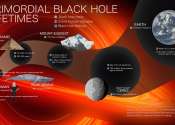New JWST observations reveal black holes rapidly shut off star formation in massive galaxies
New research published in Nature showcases new observations from the James Webb Space Telescope (JWST) that suggest black holes rapidly shut off star-formation in massive galaxies by explosively removing large amounts of ...




